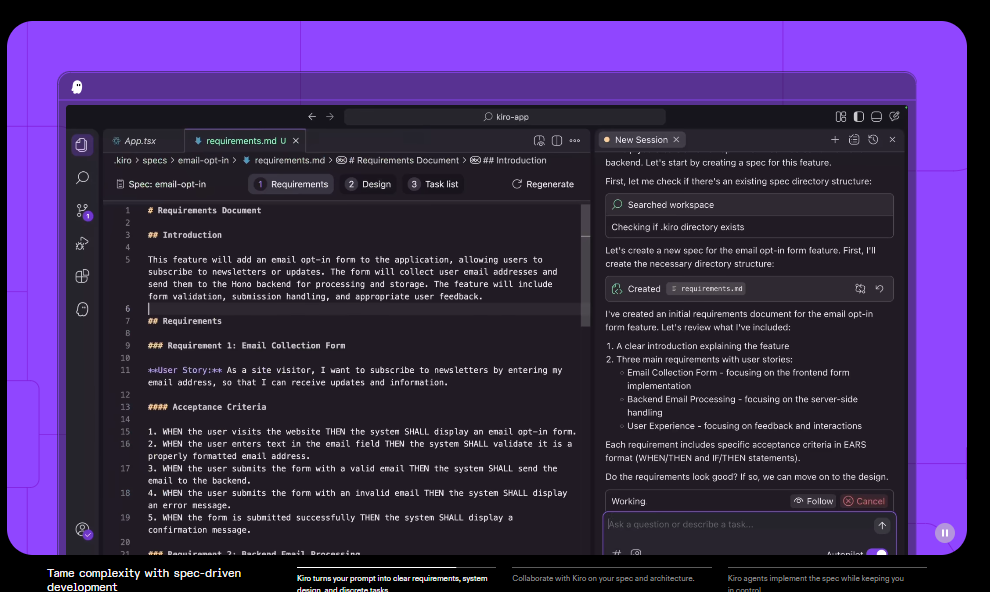AWS, a cloud computing service under Amazon, has officially launched its new AI-powered integrated development environment (IDE) called Kiro. This tool aims to revolutionize the software development process through "Spec-Driven Development," addressing the chaos and inefficiency caused by "Vibe Coding," and providing seamless support for developers from prototyping to production environments. Below is an in-depth report from AIbase on the release and features of Kiro.
Kiro's Core Innovation: From Vibe Coding to Spec-Driven Development
Different from traditional AI code generation tools such as GitHub Copilot or Google Gemini CodeAssist, Kiro's biggest highlight is emphasizing the central role of specifications (Specs) in the development process. Unlike tools that generate code directly based on prompts, Kiro collaborates with developers to first create detailed requirement documents, system designs, and task lists before generating code, test cases, and documentation based on these specifications.
For example, after a developer inputs the natural language prompt "Add a comment system to the product," Kiro will automatically generate EARS (Easy Approach to Requirements Syntax) standard user stories covering functions like viewing, creating, filtering, and rating comments, along with design documents including data flow diagrams, TypeScript interfaces, database schemas, and API endpoints. This process ensures clear code logic and maintainability, reducing technical debt accumulated from quickly generated code.

Based on Code OSS, Compatibility and Flexibility Coexist
Kiro is built on the open-source Code OSS platform (the base version of Visual Studio Code), perfectly compatible with VS Code settings, themes, and Open VSX plugins. Developers can seamlessly transition without changing their existing habits. Additionally, Kiro supports the Model Context Protocol (MCP), allowing developers to connect external tools, and plans to support more AI models, currently defaulting to Anthropic's Claude Sonnet 4 and Sonnet 3.7.
Notably, Kiro is not limited to the AWS ecosystem but is released as an independent brand. Developers do not even need an AWS account to use it (supporting Google account login). This strategy demonstrates Amazon's ambition to attract a broader developer community.
Key Features: Emphasis on Automation and Collaboration
Kiro introduces innovative features such as "Agent Hooks" and "Adaptive UI." Agent Hooks are an automated mechanism that triggers background tasks when code is saved or submitted, such as automatically generating unit tests, integration tests, or updating documentation, ensuring consistency between code and specifications. The Adaptive UI dynamically adjusts the interface based on the developer's workflow, providing an intuitive interaction experience.
In addition, Kiro supports multimodal input, allowing developers to upload hand-drawn architecture diagrams, which Kiro converts into AWS CDK code. This flexibility allows Kiro to find a balance between rapid prototyping and enterprise-level production code development.
Free Preview and Future Commercialization Plans
Currently, Kiro is in a free preview phase, supporting macOS, Windows, and Linux systems. A free and paid version will be released in the future. Amazon has promised that code data from paid users will not be used for model training, and free users can also choose to opt out of data usage. An AWS executive stated that Kiro's goal is not only to improve development efficiency but also to "redefine how developers build software."
On social media, initial feedback from developers about Kiro has been mixed. Some users have praised its structured and automated features based on specification-driven development, noting its performance in complex projects; however, some developers have indicated that Kiro's multimodal design may be slightly complex during initial use.
Market Competition and Industry Impact
Kiro's launch has placed Amazon squarely in the competitive AI coding tool market, directly targeting Cursor, Windsurf, and Microsoft's Visual Studio Code Agent Mode. Recently, Google acquired the Windsurf team through a $2.4 billion licensing deal, further intensifying competition in this field. Kiro's unique positioning lies in its emphasis on specification-driven and production-ready code, aiming to address pain points in AI-generated code regarding maintenance and scalability.
Amazon CEO Andy Jassy said on social media, "Kiro has the potential to change the way developers build software." This ambition indicates that Amazon not only wants to maintain its leadership in the cloud computing sector but also aims to secure a place in the AI-driven development tools market.
From AIbase's perspective, Kiro's release marks a significant step forward for AI coding tools moving from "rapid prototyping" to "production readiness." Its specification-driven approach and strong automation features may attract enterprise developers dealing with large codebases. However, Kiro's complexity could present a learning curve for independent developers or small projects. Amazon needs to balance usability and functionality in future optimizations.
As the free preview progresses, Kiro's actual performance and user feedback will be key factors in determining whether it can stand out in the competitive market. AIbase will continue to monitor Kiro's development and its impact on the software development industry.
Website: https://kiro.dev/
